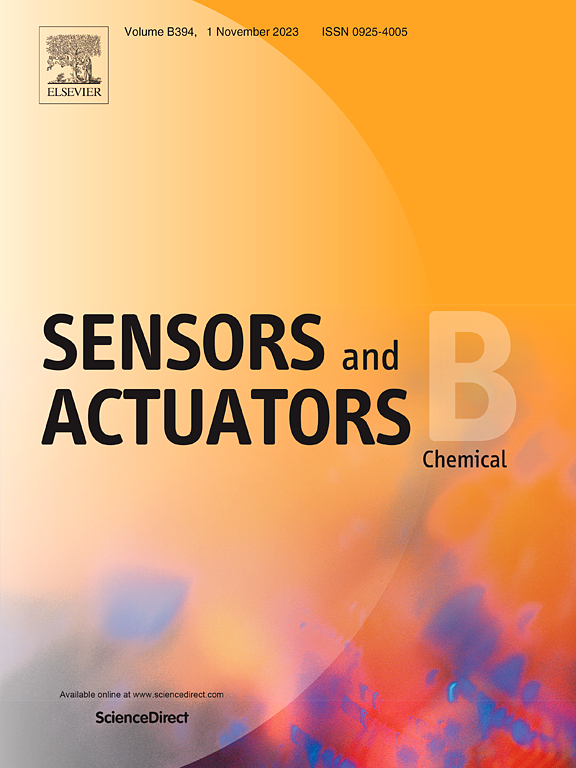基于碳化铌(Nb2C) mxenapta传感器的自组装AuNPs在女性汗液和血清样本中识别黄体酮
IF 8
1区 化学
Q1 CHEMISTRY, ANALYTICAL
引用次数: 0
摘要
个体化跟踪女性激素孕酮水平对妇女健康产生重大影响,包括生育和致癌风险。然而,目前的方法很难在室内使用,因为它们通常需要侵入式采样或大型分析实验室设备。在这里,我们报道了一种直接的电化学生物传感器,该传感器基于适体靶诱导的链位移,通过原位血清和汗液监测,用于自动和微创诊断黄体酮。这种检测丝网印刷碳电极(SPCE)结合了一种无试剂信号增强和“信号启动”识别策略,通过(3-氨基丙基)三乙氧基硅烷(APTES)功能化Nb2C(碳化铌)MXene纳米片修饰的金纳米颗粒(AuNPs)在皮摩尔浓度下具有高特异性和卓越的灵敏度。该装置可以在50 ~ 160 pM范围内线性检测黄体酮水平,灵敏度为0.159µa pM−1,检测限(LOD)在PBS缓冲液(pH 7.4)中为14 pM,在添加的女性汗液样品中为17 pM。我们集成的基于适配体的SPCE系统已成功地在实时临床样品中进行了现场测试。AuNPs-APTES-Nb2C-MXene纳米片上的适体修饰为生物医学和电化学传感应用开辟了新的可能性,在皮摩尔浓度的黄体酮检测中具有出色的稳定性、可重复性、特异性、敏感性和选择性。本文章由计算机程序翻译,如有差异,请以英文原文为准。

Self-assembled AuNPs on niobium carbide (Nb2C) MXene-based apta-sensor for progesterone recognition in female sweat and serum sample
Individualized tracking of female hormones progesterone level raises a significant impact on women's health, including fertility and carcinogenic risks. Nevertheless, current methods are difficult to use indoors because they typically call for intrusive sampling or large analytical laboratory equipment. Here, we report a straightforward electrochemical biosensor based on the aptamer-target-induced displacement of strands for the automated and minimally invasive diagnostic progesterone via in situ serum and sweat monitoring. This detection screen-printed carbon electrode (SPCE) combines a reagent-less signal enhancement and 'signal-on' recognition strategy with a gold nanoparticle (AuNPs) decorated via (3-aminopropyl) triethoxysilane (APTES) functionalized Nb2C (niobium carbide) MXene nanosheets achieves high specificity and exceptional sensitivity at picomolar concentrations. The device could detect progesterone levels linearly within the 50–160 pM range, with a sensitivity of 0.159 µA pM−1 and a limit of detection (LOD) of 14 pM in PBS buffer (pH 7.4) and 17 pM in the spiked female sweat sample. Our integrated aptamer-based SPCE system was successfully demonstrated in real-time clinical samples at point-of-care testing. Aptamer modification on AuNPs-APTES-Nb2C-MXene nanosheets opens up new possibilities for biomedical and electrochemical sensing applications in progesterone detection at picomolar concentration exhibits exceptional stability, repeatability, specificity, sensitivity, and selectivity.
求助全文
通过发布文献求助,成功后即可免费获取论文全文。
去求助
来源期刊

Sensors and Actuators B: Chemical
工程技术-电化学
CiteScore
14.60
自引率
11.90%
发文量
1776
审稿时长
3.2 months
期刊介绍:
Sensors & Actuators, B: Chemical is an international journal focused on the research and development of chemical transducers. It covers chemical sensors and biosensors, chemical actuators, and analytical microsystems. The journal is interdisciplinary, aiming to publish original works showcasing substantial advancements beyond the current state of the art in these fields, with practical applicability to solving meaningful analytical problems. Review articles are accepted by invitation from an Editor of the journal.
 求助内容:
求助内容: 应助结果提醒方式:
应助结果提醒方式:


